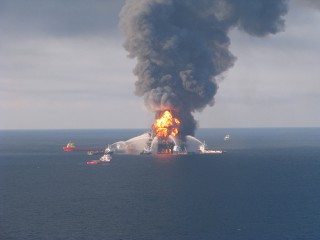* By: Jason Leopold t r u t h o u t *

A former contractor who worked for British Petroleum (BP) claims the oil conglomerate broke federal laws and violated its own internal procedures by failing to maintain crucial safety and engineering documents related to one of the firms other deep water production projects in the Gulf of Mexico, according to internal emails and other documents obtained by Truthout.
The whistle-blower, whose name has been withheld at the person’s request because the whistle-blower still works in the oil industry and fears retaliation, first raised concerns about safety issues related to BP Atlantis, the world’s largest and deepest semi-submersible oil and natural gas platform, located about 200 miles south of New Orleans, in November 2008. Atlantis, which began production in October 2007, has the capacity to produce about 8.4 million gallons of oil and 180 million cubic feet of natural gas per day.
It was then that the whistle-blower, who was hired to oversee the company’s databases that housed documents related to its Atlantis project, discovered that the drilling platform had been operating without a majority of the engineer-approved documents it needed to run safely, leaving the platform vulnerable to a catastrophic disaster that would far surpass the massive oil spill that began last week following a deadly explosion on a BP-operated drilling rig.
BP’s own internal communications show that company officials were made aware of the issue and feared that the document shortfalls related to Atlantis “could lead to catastrophic operator error” and must be addressed.
Indeed, according to an August 15, 2008, email sent to BP officials by Barry Duff, a member of BP’s Deep water Gulf of Mexico Atlantis Subsea Team, the Piping and Instrument Diagrams (P&IDs) for the Atlantis subsea components “are not complete.” P&IDs documents form the foundation of a hazards analysis BP is required to undertake as part of its Safety and Environmental Management Program related to its offshore drilling operations. P&IDs drawings provide the schematic details of the project’s piping and process flows, valves and safety critical instrumentation.
“The risk in turning over drawings that are not complete are: 1) The Operator will assume the drawings are accurate and up to date,” the email said. “This could lead to catastrophic Operator errors due to their assuming the drawing is correct,” said Duff’s email to BP officials Bill Naseman and William Broman. “Turning over incomplete drawings to the Operator for their use is a fundamental violation of basic Document control, [internal standards] and Process Safety Regulations.”
Read more at t r u t h o u t
NOAA Situation Update 30 Apr 10
ATTENTION READERS
We See The World From All Sides and Want YOU To Be Fully InformedIn fact, intentional disinformation is a disgraceful scourge in media today. So to assuage any possible errant incorrect information posted herein, we strongly encourage you to seek corroboration from other non-VT sources before forming an educated opinion.
About VT - Policies & Disclosures - Comment Policy



